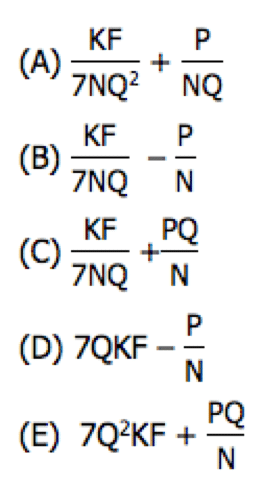First, try these challenging GMAT Quantitative problems, all variations on a theme, as you will see.
1) Seven children — A, B, C, D, E, F, and G — are going to sit in seven chairs in a row. The children C & F have to sit next to each other, and the others can sit in any order in any remaining chairs. How many possible configurations are there for the children?
-
(A) 600
(B) 720
(C) 1440
(D) 4320
(E) 4800
2) Seven children — A, B, C, D, E, F, and G — are going to sit in seven chairs in a row. Child A has to sit next to both B & G, with these two children immediately adjacent to here on either side. The other four children can sit in any order in any of the remaining seats. How many possible configurations are there for the children?
-
(A) 240
(B) 480
(C) 720
(D) 1440
(E) 3600
3) Six children — A, B, C, D, E, and F — are going to sit in six chairs in a row. Child E must be somewhere to the left of child F. How many possible configurations are there for the children?
-
(A) 60
(B) 180
(C) 240
(D) 360
(E) 720
4) Seven children — A, B, C, D, E, F, and G — are going to sit in seven chairs in a row. Children A & B must sit next to each other, and child C must be somewhere to the right of A & B. How many possible configurations are there for the children?
-
(A) 600
(B) 720
(C) 1440
(D) 4320
(E) 4800
If these problems make your head spin, then you have found the right post!
The basics of counting
First of all, it’s vitally important to understand something called the Fundamental Counting Principle (FCP). It’s also important to understand permutations and combinations. These ideas underlie all the introductory counting problems on the GMAT Quantitative section, and they form the basis of what we will discuss in these posts.
Start with the restriction
Whenever you are counting arrangements or possibilities in a complex scenario, always start with the most restrictive feature or element. Quite often, the plan is — (a) count all the possibilities for the elements with restrictions; (b) count all the possibilities for the remaining non-restricted items; (c) by the FCP, multiply those numbers together.
For example, let’s take a simple case, a bit simpler than anything the GMAT will throw your way. Suppose we have five children, A, B, C, D, and E, and we are going to sit them in five chairs in a row, with the restriction that B & C have to be next to each other.
Step #1: consider the restricted elements, B & C. They have to be next to each other. How many “next to each other pairs are there among the four seats?
X X _ _ _
_ X X _ _
_ _ X X _
_ _ _ X X
There are those four possible pairs. Now, B & C can be in either order in any of those, so that’s 4*2 = 8 possibilities for these two children.
Step #2: now, the non-restricted elements. Once B & C are seated, we can put A & D & E in any order in the remaining three seats. Three elements in any order — that’s a permutation — 3! = 6. For any particular configuration of B & C, the remaining three can be seated in 6 different ways.
Step #3: combine with the FCP. Children B & C can be seated in 8 different configurations, and for each one of those, A & D & E can be seated in 6 different configurations. Total number of configurations = 6*8 = 48.
That’s the basic process, which can be expanded for larger numbers of items. Having seen that, you may want to give the problems above a second look before reading through the explanations below. If those problems still are confounding for you, read through the solutions below very carefully. If you thoroughly understand the four problems at the top of this post, you will be able to handle anything counting problem GMAT will give you.
Practice problem explanations
1) First, we will consider the restricted elements — C & F. How many ways can they sit next to each other in a row of seven chairs? Well, first of all, how many “next to each other” pairs of chairs are there?
X X _ _ _ _ _
_ X X _ _ _ _
_ _ X X _ _ _
_ _ _ X X _ _
_ _ _ _ X X _
_ _ _ _ _ X X
There are six different pairs of “next to each other” chairs. For each pair, children C & F could be in either order, so that’s 6*2 = 12 possibilities for these two.
Now, consider the other five children. For any configuration of C & F, the remaining five children could be seated in any order among the five remaining seats. Five items in any order — that’s a combination of the 5 items —- 5P5 = 5! = 120. For any single configuration of C & F, there are 120 ways that the other children could be seated in the remaining seats.
Finally, we’ll combine with the Fundamental Counting Principle. We have 12 ways for the first two, and 120 ways for the remaining five. That’s a total number of configurations of 12*120 = 1440. Answer = C
2) First, we will consider the restricted elements — children A & B & G have to be in three seats in a row. How many “three in a row” seats are there in a row of seven seats?
X X X _ _ _ _
_ X X X _ _ _
_ _ X X X _ _
_ _ _ X X X _
_ _ _ _ X X X
There are five different “three in a row” locations for these three children. Now, for any given triplet of seats, we know A has to be in the middle, so the children could be seated B-A-G or G-A-B — just those two orders. This means the total number of configurations for these three children is 5*2 = 10.
Now, consider the non-restricted elements, the other four. Once A & B & G are seated, the remaining four children can be seated in any order among the remaining four seats — that’s a permutation of the 4 items —- 4P4 = 4! = 24. For any single configuration of A & B & G, there are 24 ways that the other children could be seated in the remaining seats.
Finally, we’ll combine with the Fundamental Counting Principle. We have 10 ways for the first three, and 24 ways for the remaining four. That’s a total number of configurations of 24*10 = 240. Answer = A
3) If we wanted, we could make this one extremely difficult, counting out all kinds of possibilities in several different cases. Instead, we are going to make this ridiculously easy.
First of all, with absolutely no restrictions, how many ways can the six children be arranged on the six chairs? That’s a permutation of the 6 items —- 6P6 = 6! = 720. That’s the total number of arrangements with no restrictions. Of course, those 720 arrangements have all kinds of symmetry to them. In particular, in all of those arrangements overall, it’s just as likely for E to be to the left of F as it is for E to be to the right of F. Therefore, exactly half must have E to the right of F, and exactly half must have E to the left of F. Therefore, exactly (1/2)*720 = 360 of the arrangements have E to the left of F. Answer = D.
4) This problem is a notch harder than anything you are likely to see on the GMAT. If you can master the principles in this problem, you certainly will be able to handle almost any problem the GMAT could concoct.
First, consider the restriction of A & B. As with problem #1 above, there are 12 possibilities for A & B, counting both position and order.
Now, put the other five in any order — that’s 120 possibilities, for a total number of configurations of 1440. That number does not take into account the restriction with C.
Think about those 1440 configurations. In exactly half of them, C will be to the right of A & B, and exactly half, C will be to the left of A & B. Therefore, in (1/2)*1440 = 720 configurations, C will be to the right of A & B. Answer = B





